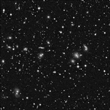 NGC 1 - 2000 |
 NGC 2001 - 4000 |
 NGC 4001 - 6000 |
 NGC 6001 + |
 IC galaxies |
 Anonymous |
 Galaxy Clusters |
 The Large |
 The Small |
|
Whether they are giant pinwheels or tiny smudges, galaxies confront the observer with just how small this planet really is. Who can observe one of these huge congregations of stars without realising the vast distances that separate the Earth from these objects.
When it comes to observing galaxies, there are a number of tricks that will aid in a successful observation. The main one is to use averted vision. By looking slightly to one side of the galaxy, this will allow the galaxy's light to fall on the portion of the retina that is most sensitive to faint light, allowing a much improved view. Another trick is to use a dark cover over your head while observing to block any stray light. This helps even in dark country skies. As most galaxies are relatively small, moderate magnification can be used to darken the background sky.
There are hundreds of galaxies that are within reach of a small telescope. Many of them are bright easy objects that are visible to the naked eye. Others can show beautiful curving spiral arms or dark dust lanes. Still others can be a real observing challenge.
 NGC 1 - 2000 |
 NGC 2001 - 4000 |
 NGC 4001 - 6000 |
 NGC 6001 + |
 IC galaxies |
 Anonymous |
 Galaxy Clusters |
 The Large |
 The Small |
|